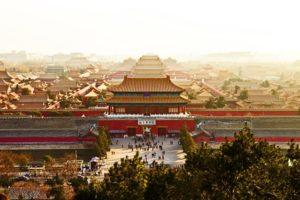Fodor's Expert Review Confucius Temple
This tranquil temple to China's great sage has endured close to eight centuries of additions and restorations. The Hall of Great Accomplishment in the temple houses Confucius's funeral tablet and shrine, flanked by copper-colored statues depicting China's wisest Confucian scholars. As in Buddhist and Taoist temples, worshippers can offer sacrifices (in this case to a mortal, not a deity). The 198 tablets lining the courtyard outside the Hall of Great Accomplishment contain 51,624 names belonging to advanced Confucian scholars from the Yuan, Ming, and Qing dynasties. Flanking the Gate of Great Accomplishment are two carved stone drums dating to the Qianlong period (1735–96). In the Hall of Great Perfection you'll find the central shrine to Confucius. Check out the huge collection of ancient musical instruments.
In the front and main courtyards of the temple you'll find a cemetery of stone tablets. These tablets, or stelae, stand like rows of crypts. On the front stelae you can... READ MORE
This tranquil temple to China's great sage has endured close to eight centuries of additions and restorations. The Hall of Great Accomplishment in the temple houses Confucius's funeral tablet and shrine, flanked by copper-colored statues depicting China's wisest Confucian scholars. As in Buddhist and Taoist temples, worshippers can offer sacrifices (in this case to a mortal, not a deity). The 198 tablets lining the courtyard outside the Hall of Great Accomplishment contain 51,624 names belonging to advanced Confucian scholars from the Yuan, Ming, and Qing dynasties. Flanking the Gate of Great Accomplishment are two carved stone drums dating to the Qianlong period (1735–96). In the Hall of Great Perfection you'll find the central shrine to Confucius. Check out the huge collection of ancient musical instruments.
In the front and main courtyards of the temple you'll find a cemetery of stone tablets. These tablets, or stelae, stand like rows of crypts. On the front stelae you can barely make out the names of thousands of scholars who passed imperial exams. Another batch of stelae, carved in the mid-1700s to record the Thirteen Classics, which are philosophical works attributed to Confucius, line the west side of the grounds.
We recommend combining a tour of the Confucius Temple with the nearby Lama Temple. Access to both is convenient from the Yonghegong subway stop at the intersection of Line 2 and Line 5. You can also easily get to the Temple of Heaven by taking Line 5 south to Tiantandongmen.
The complex is now combined with the Imperial Academy next door, once the highest educational institution in the country. Established in 1306 as a rigorous training ground for high-level government officials, the academy was notorious, especially during the early Ming Dynasty era, for the harsh discipline imposed on scholars perfecting their knowledge of the Confucian classics. The Riyong Emperors Lecture Hall is surrounded by a circular moat (although the building is rectangular in shape). Emperors would come here to lecture on the classics. This ancient campus would be a glorious place to study today with its washed red walls, gold-tiled roofs, and towering cypresses (some as old as 700 years).
READ LESS







